Understanding the Business Environment: Organizations and Stakeholders
VerifiedAdded on 2024/05/30
|18
|4404
|354
Report
AI Summary
This assignment provides an overview of the business environment and its impact on organizations. It examines different types of organizations, including for-profit, non-profit, and NGOs, highlighting their varying purposes and approaches to supplying goods and services. The report also categorizes enterprises by size (micro, small, medium, and large), discussing their market share, profit share, growth, and sustainability, particularly focusing on SMEs in the UK. Furthermore, it delves into organizational structures, such as divisional, product, financial, market, and operational structures, and the complexities involved in transnational, international, and global organizations. The assignment emphasizes the importance of understanding these factors for effective decision-making and organizational success. Desklib offers additional resources and solved assignments for students.
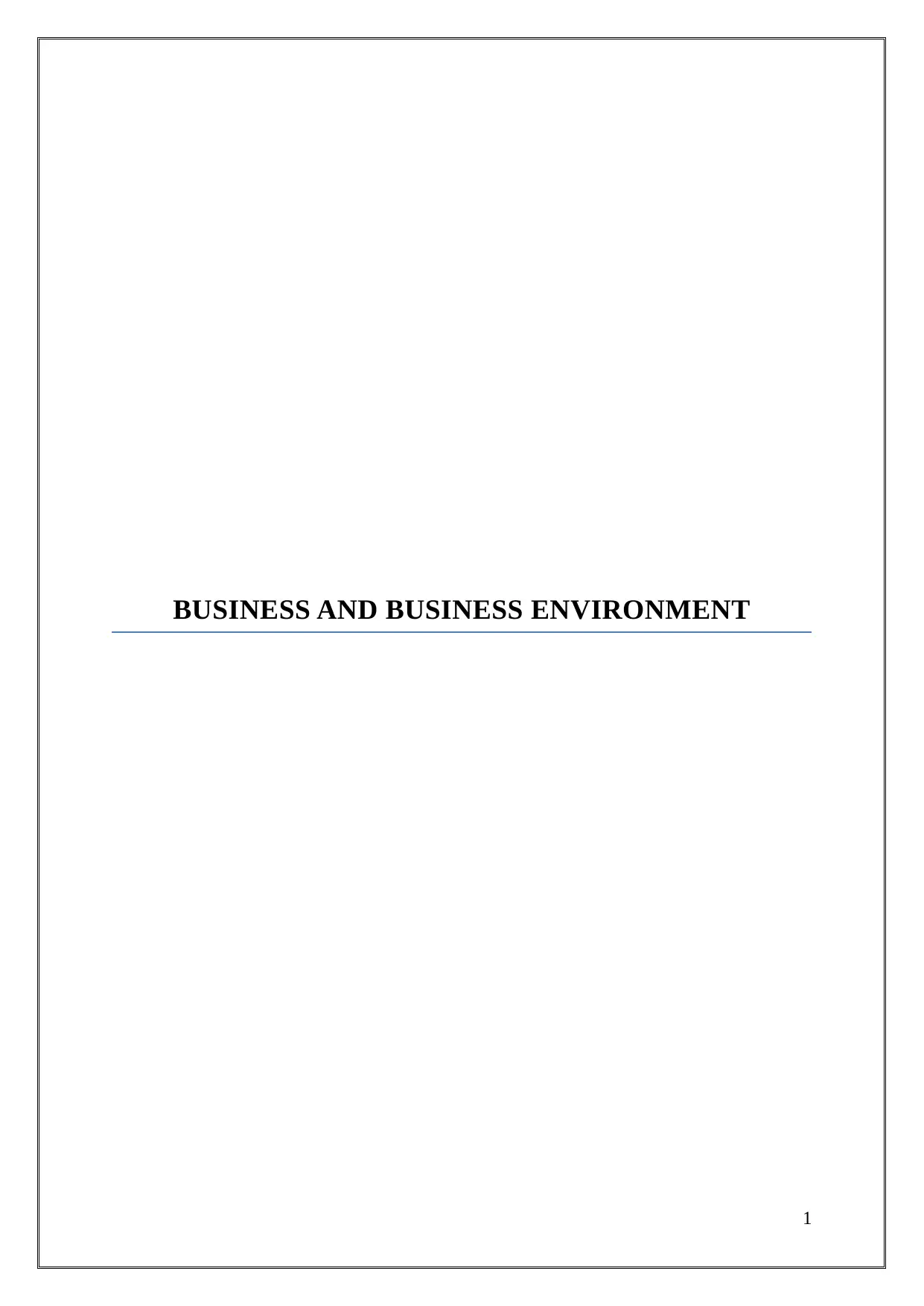
BUSINESS AND BUSINESS ENVIRONMENT
1
1
Paraphrase This Document
Need a fresh take? Get an instant paraphrase of this document with our AI Paraphraser
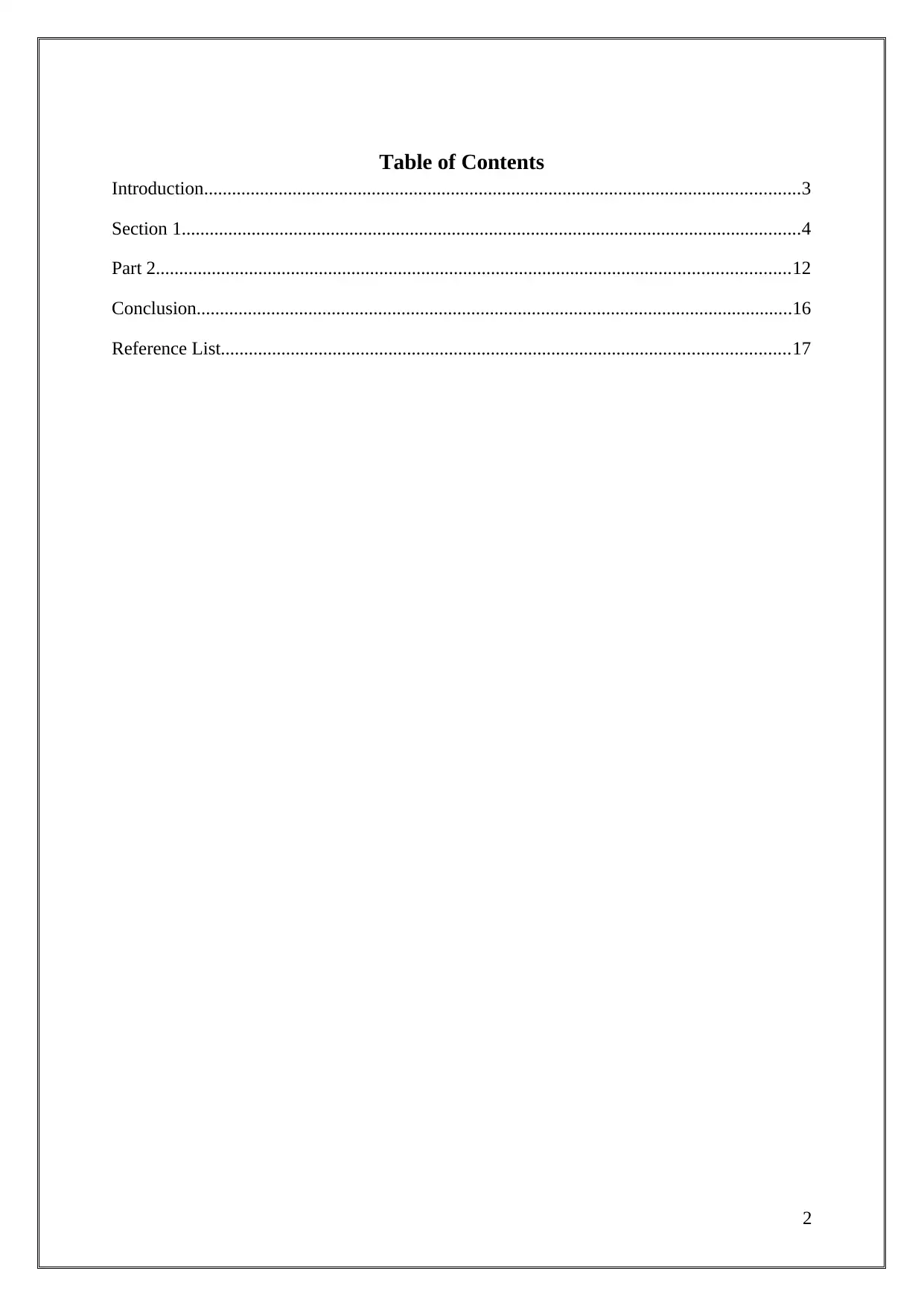
Table of Contents
Introduction................................................................................................................................3
Section 1.....................................................................................................................................4
Part 2........................................................................................................................................12
Conclusion................................................................................................................................16
Reference List..........................................................................................................................17
2
Introduction................................................................................................................................3
Section 1.....................................................................................................................................4
Part 2........................................................................................................................................12
Conclusion................................................................................................................................16
Reference List..........................................................................................................................17
2
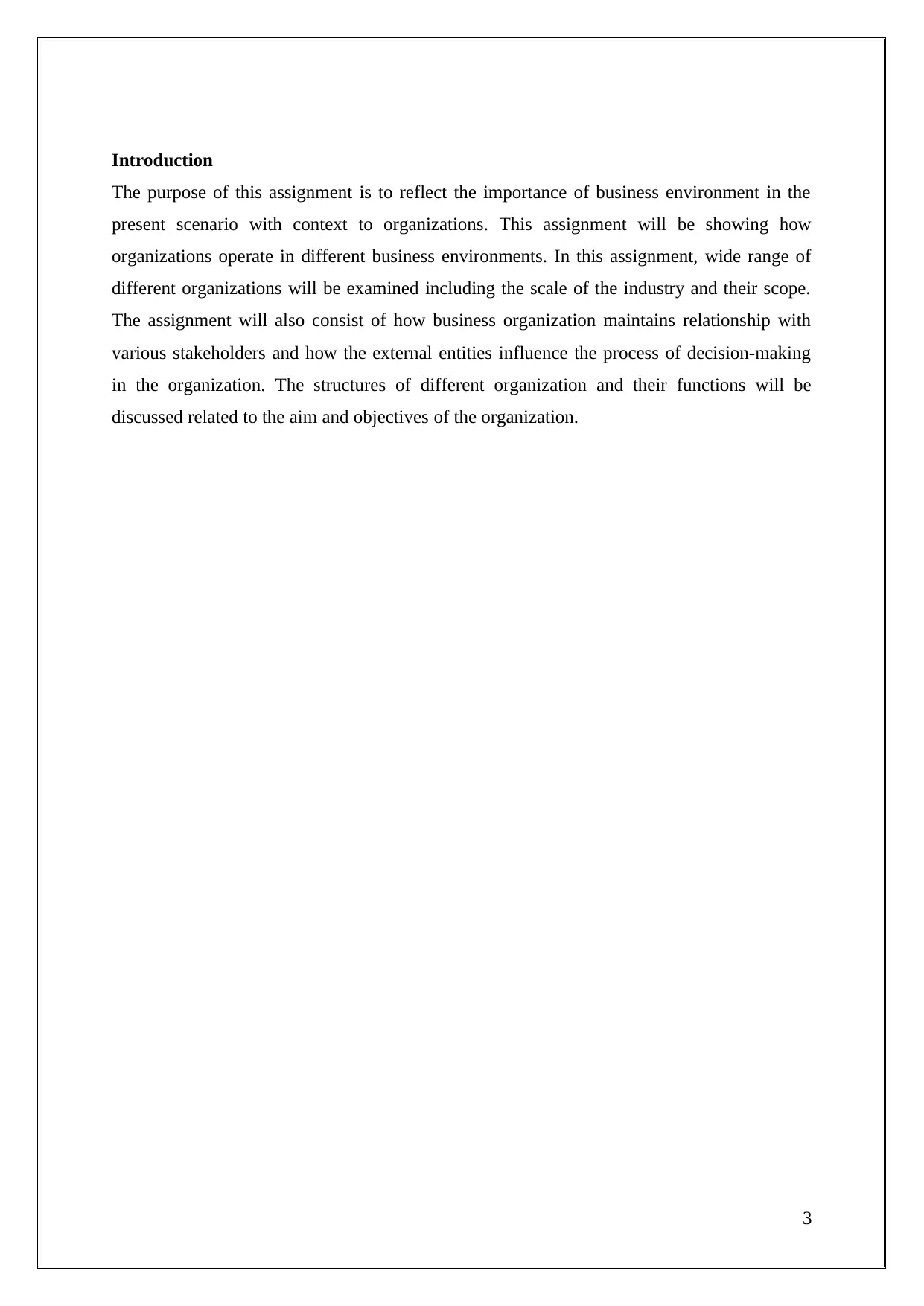
Introduction
The purpose of this assignment is to reflect the importance of business environment in the
present scenario with context to organizations. This assignment will be showing how
organizations operate in different business environments. In this assignment, wide range of
different organizations will be examined including the scale of the industry and their scope.
The assignment will also consist of how business organization maintains relationship with
various stakeholders and how the external entities influence the process of decision-making
in the organization. The structures of different organization and their functions will be
discussed related to the aim and objectives of the organization.
3
The purpose of this assignment is to reflect the importance of business environment in the
present scenario with context to organizations. This assignment will be showing how
organizations operate in different business environments. In this assignment, wide range of
different organizations will be examined including the scale of the industry and their scope.
The assignment will also consist of how business organization maintains relationship with
various stakeholders and how the external entities influence the process of decision-making
in the organization. The structures of different organization and their functions will be
discussed related to the aim and objectives of the organization.
3
⊘ This is a preview!⊘
Do you want full access?
Subscribe today to unlock all pages.

Trusted by 1+ million students worldwide
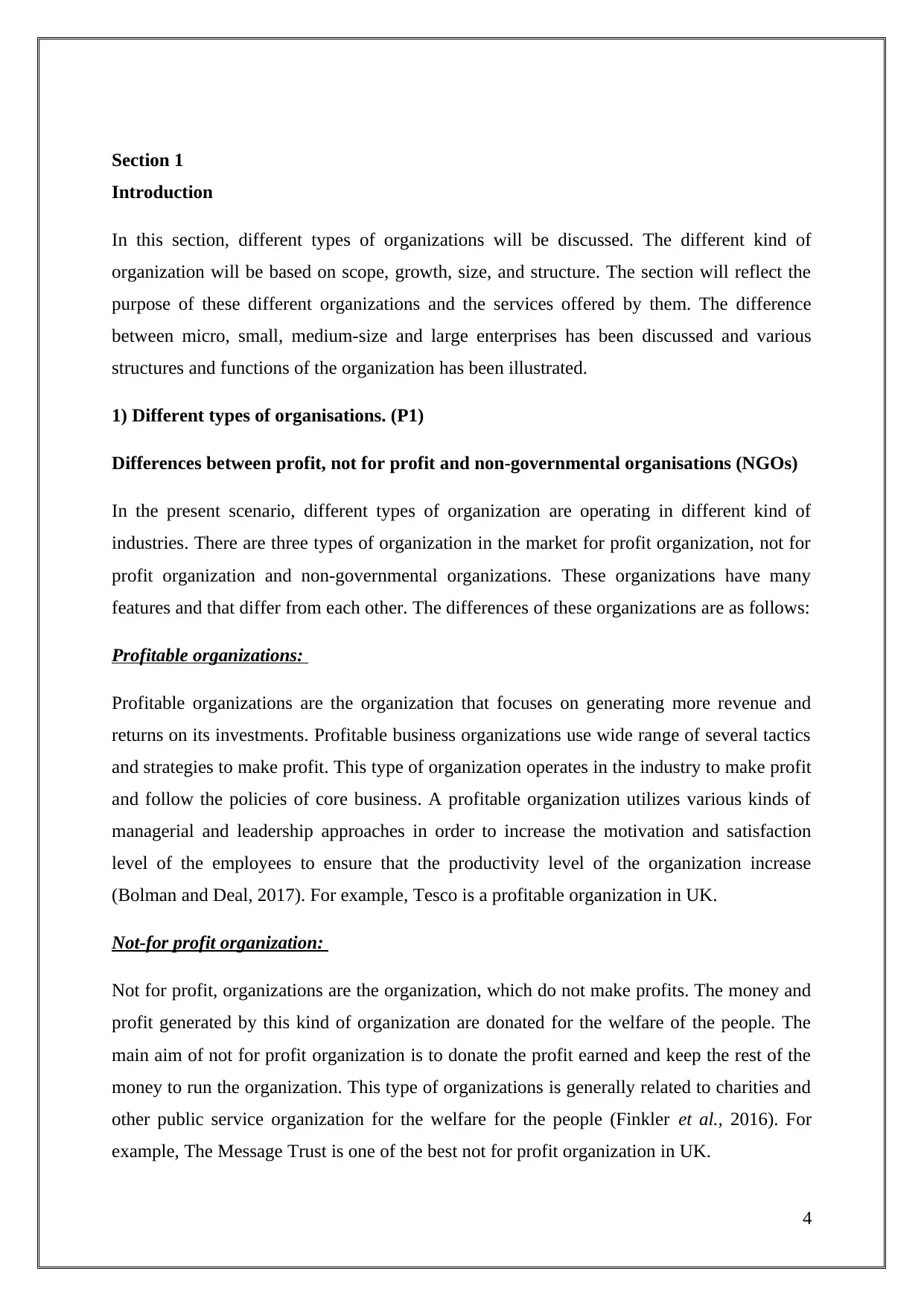
Section 1
Introduction
In this section, different types of organizations will be discussed. The different kind of
organization will be based on scope, growth, size, and structure. The section will reflect the
purpose of these different organizations and the services offered by them. The difference
between micro, small, medium-size and large enterprises has been discussed and various
structures and functions of the organization has been illustrated.
1) Different types of organisations. (P1)
Differences between profit, not for profit and non-governmental organisations (NGOs)
In the present scenario, different types of organization are operating in different kind of
industries. There are three types of organization in the market for profit organization, not for
profit organization and non-governmental organizations. These organizations have many
features and that differ from each other. The differences of these organizations are as follows:
Profitable organizations:
Profitable organizations are the organization that focuses on generating more revenue and
returns on its investments. Profitable business organizations use wide range of several tactics
and strategies to make profit. This type of organization operates in the industry to make profit
and follow the policies of core business. A profitable organization utilizes various kinds of
managerial and leadership approaches in order to increase the motivation and satisfaction
level of the employees to ensure that the productivity level of the organization increase
(Bolman and Deal, 2017). For example, Tesco is a profitable organization in UK.
Not-for profit organization:
Not for profit, organizations are the organization, which do not make profits. The money and
profit generated by this kind of organization are donated for the welfare of the people. The
main aim of not for profit organization is to donate the profit earned and keep the rest of the
money to run the organization. This type of organizations is generally related to charities and
other public service organization for the welfare for the people (Finkler et al., 2016). For
example, The Message Trust is one of the best not for profit organization in UK.
4
Introduction
In this section, different types of organizations will be discussed. The different kind of
organization will be based on scope, growth, size, and structure. The section will reflect the
purpose of these different organizations and the services offered by them. The difference
between micro, small, medium-size and large enterprises has been discussed and various
structures and functions of the organization has been illustrated.
1) Different types of organisations. (P1)
Differences between profit, not for profit and non-governmental organisations (NGOs)
In the present scenario, different types of organization are operating in different kind of
industries. There are three types of organization in the market for profit organization, not for
profit organization and non-governmental organizations. These organizations have many
features and that differ from each other. The differences of these organizations are as follows:
Profitable organizations:
Profitable organizations are the organization that focuses on generating more revenue and
returns on its investments. Profitable business organizations use wide range of several tactics
and strategies to make profit. This type of organization operates in the industry to make profit
and follow the policies of core business. A profitable organization utilizes various kinds of
managerial and leadership approaches in order to increase the motivation and satisfaction
level of the employees to ensure that the productivity level of the organization increase
(Bolman and Deal, 2017). For example, Tesco is a profitable organization in UK.
Not-for profit organization:
Not for profit, organizations are the organization, which do not make profits. The money and
profit generated by this kind of organization are donated for the welfare of the people. The
main aim of not for profit organization is to donate the profit earned and keep the rest of the
money to run the organization. This type of organizations is generally related to charities and
other public service organization for the welfare for the people (Finkler et al., 2016). For
example, The Message Trust is one of the best not for profit organization in UK.
4
Paraphrase This Document
Need a fresh take? Get an instant paraphrase of this document with our AI Paraphraser
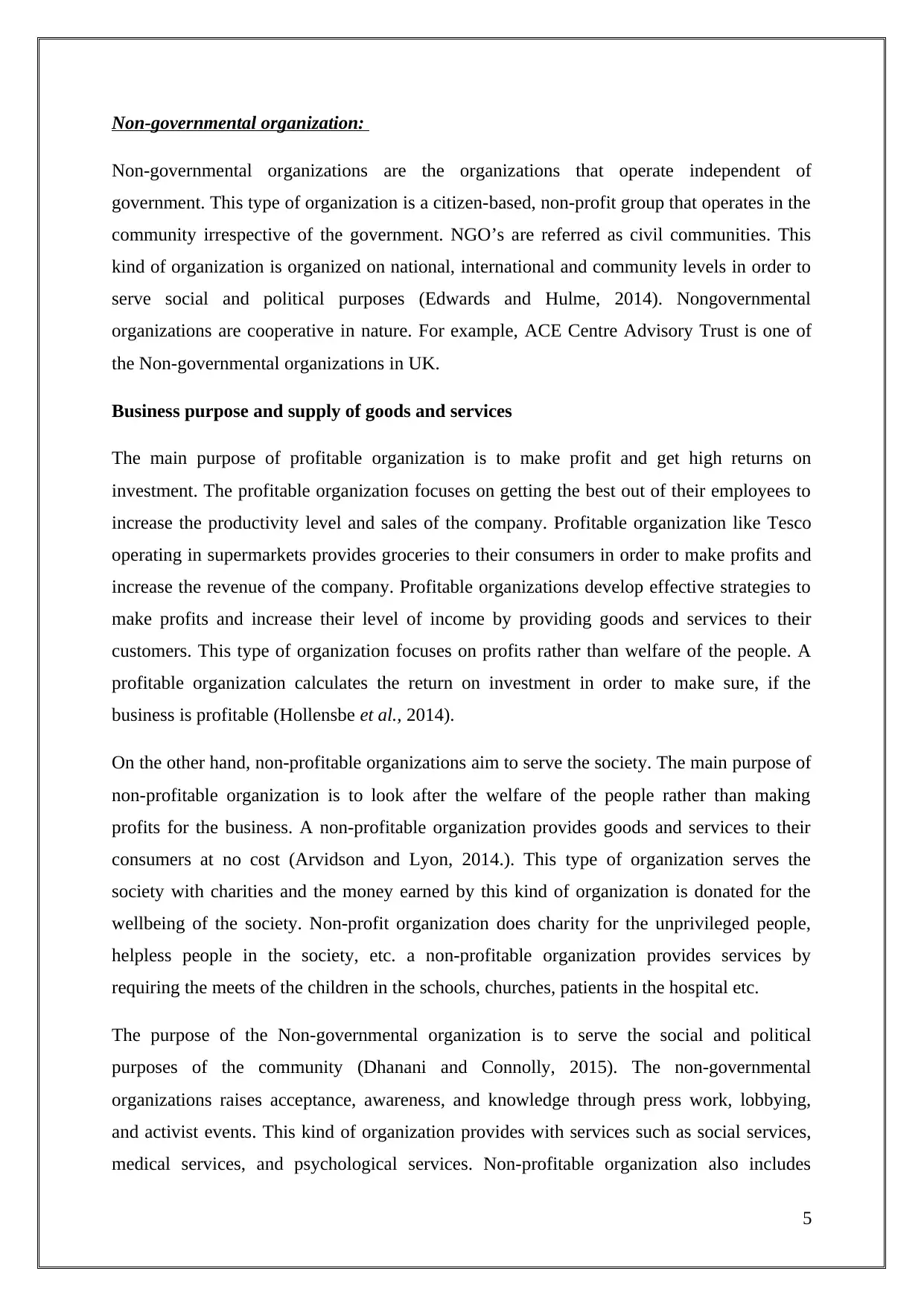
Non-governmental organization:
Non-governmental organizations are the organizations that operate independent of
government. This type of organization is a citizen-based, non-profit group that operates in the
community irrespective of the government. NGO’s are referred as civil communities. This
kind of organization is organized on national, international and community levels in order to
serve social and political purposes (Edwards and Hulme, 2014). Nongovernmental
organizations are cooperative in nature. For example, ACE Centre Advisory Trust is one of
the Non-governmental organizations in UK.
Business purpose and supply of goods and services
The main purpose of profitable organization is to make profit and get high returns on
investment. The profitable organization focuses on getting the best out of their employees to
increase the productivity level and sales of the company. Profitable organization like Tesco
operating in supermarkets provides groceries to their consumers in order to make profits and
increase the revenue of the company. Profitable organizations develop effective strategies to
make profits and increase their level of income by providing goods and services to their
customers. This type of organization focuses on profits rather than welfare of the people. A
profitable organization calculates the return on investment in order to make sure, if the
business is profitable (Hollensbe et al., 2014).
On the other hand, non-profitable organizations aim to serve the society. The main purpose of
non-profitable organization is to look after the welfare of the people rather than making
profits for the business. A non-profitable organization provides goods and services to their
consumers at no cost (Arvidson and Lyon, 2014.). This type of organization serves the
society with charities and the money earned by this kind of organization is donated for the
wellbeing of the society. Non-profit organization does charity for the unprivileged people,
helpless people in the society, etc. a non-profitable organization provides services by
requiring the meets of the children in the schools, churches, patients in the hospital etc.
The purpose of the Non-governmental organization is to serve the social and political
purposes of the community (Dhanani and Connolly, 2015). The non-governmental
organizations raises acceptance, awareness, and knowledge through press work, lobbying,
and activist events. This kind of organization provides with services such as social services,
medical services, and psychological services. Non-profitable organization also includes
5
Non-governmental organizations are the organizations that operate independent of
government. This type of organization is a citizen-based, non-profit group that operates in the
community irrespective of the government. NGO’s are referred as civil communities. This
kind of organization is organized on national, international and community levels in order to
serve social and political purposes (Edwards and Hulme, 2014). Nongovernmental
organizations are cooperative in nature. For example, ACE Centre Advisory Trust is one of
the Non-governmental organizations in UK.
Business purpose and supply of goods and services
The main purpose of profitable organization is to make profit and get high returns on
investment. The profitable organization focuses on getting the best out of their employees to
increase the productivity level and sales of the company. Profitable organization like Tesco
operating in supermarkets provides groceries to their consumers in order to make profits and
increase the revenue of the company. Profitable organizations develop effective strategies to
make profits and increase their level of income by providing goods and services to their
customers. This type of organization focuses on profits rather than welfare of the people. A
profitable organization calculates the return on investment in order to make sure, if the
business is profitable (Hollensbe et al., 2014).
On the other hand, non-profitable organizations aim to serve the society. The main purpose of
non-profitable organization is to look after the welfare of the people rather than making
profits for the business. A non-profitable organization provides goods and services to their
consumers at no cost (Arvidson and Lyon, 2014.). This type of organization serves the
society with charities and the money earned by this kind of organization is donated for the
wellbeing of the society. Non-profit organization does charity for the unprivileged people,
helpless people in the society, etc. a non-profitable organization provides services by
requiring the meets of the children in the schools, churches, patients in the hospital etc.
The purpose of the Non-governmental organization is to serve the social and political
purposes of the community (Dhanani and Connolly, 2015). The non-governmental
organizations raises acceptance, awareness, and knowledge through press work, lobbying,
and activist events. This kind of organization provides with services such as social services,
medical services, and psychological services. Non-profitable organization also includes
5
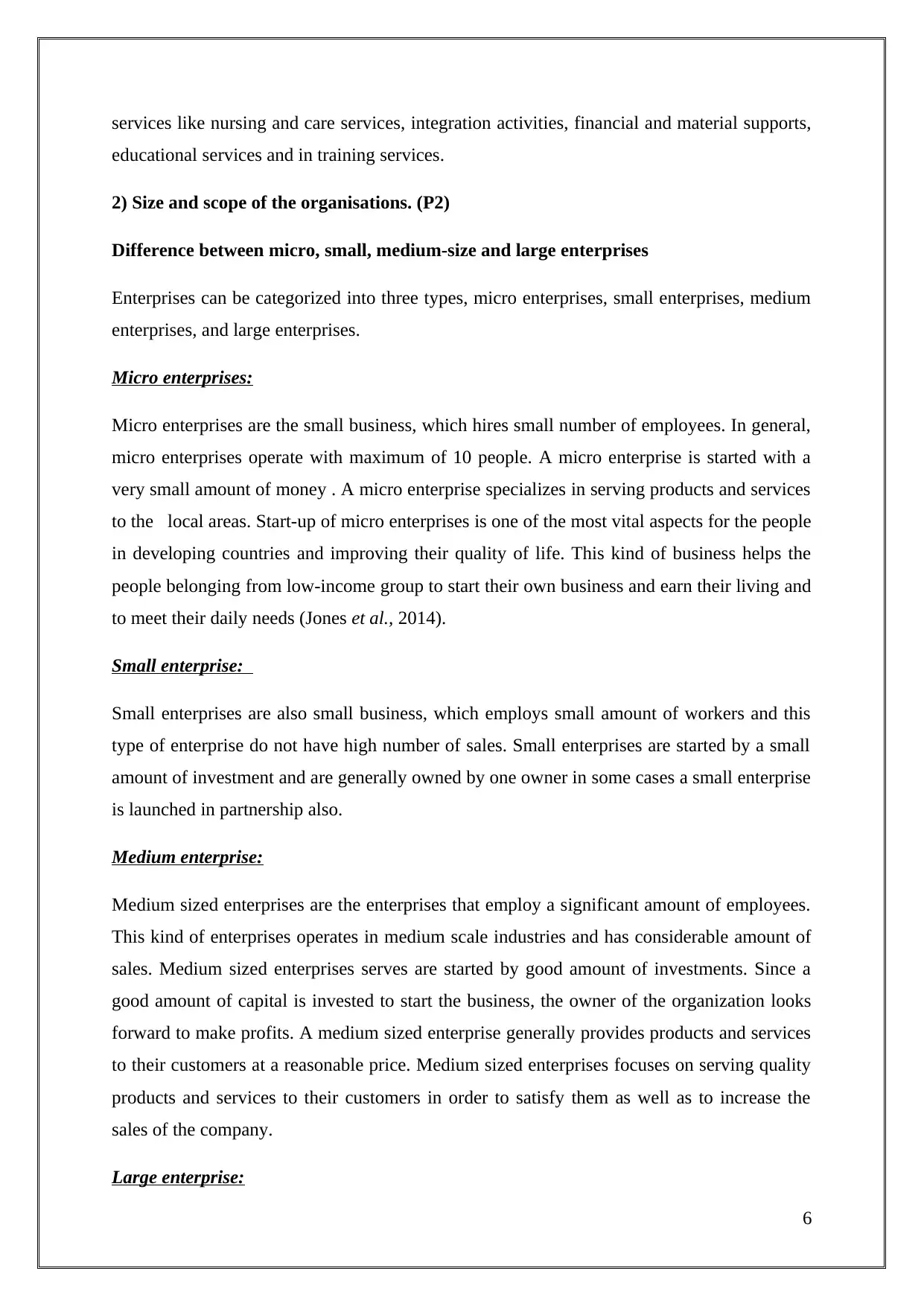
services like nursing and care services, integration activities, financial and material supports,
educational services and in training services.
2) Size and scope of the organisations. (P2)
Difference between micro, small, medium-size and large enterprises
Enterprises can be categorized into three types, micro enterprises, small enterprises, medium
enterprises, and large enterprises.
Micro enterprises:
Micro enterprises are the small business, which hires small number of employees. In general,
micro enterprises operate with maximum of 10 people. A micro enterprise is started with a
very small amount of money . A micro enterprise specializes in serving products and services
to the local areas. Start-up of micro enterprises is one of the most vital aspects for the people
in developing countries and improving their quality of life. This kind of business helps the
people belonging from low-income group to start their own business and earn their living and
to meet their daily needs (Jones et al., 2014).
Small enterprise:
Small enterprises are also small business, which employs small amount of workers and this
type of enterprise do not have high number of sales. Small enterprises are started by a small
amount of investment and are generally owned by one owner in some cases a small enterprise
is launched in partnership also.
Medium enterprise:
Medium sized enterprises are the enterprises that employ a significant amount of employees.
This kind of enterprises operates in medium scale industries and has considerable amount of
sales. Medium sized enterprises serves are started by good amount of investments. Since a
good amount of capital is invested to start the business, the owner of the organization looks
forward to make profits. A medium sized enterprise generally provides products and services
to their customers at a reasonable price. Medium sized enterprises focuses on serving quality
products and services to their customers in order to satisfy them as well as to increase the
sales of the company.
Large enterprise:
6
educational services and in training services.
2) Size and scope of the organisations. (P2)
Difference between micro, small, medium-size and large enterprises
Enterprises can be categorized into three types, micro enterprises, small enterprises, medium
enterprises, and large enterprises.
Micro enterprises:
Micro enterprises are the small business, which hires small number of employees. In general,
micro enterprises operate with maximum of 10 people. A micro enterprise is started with a
very small amount of money . A micro enterprise specializes in serving products and services
to the local areas. Start-up of micro enterprises is one of the most vital aspects for the people
in developing countries and improving their quality of life. This kind of business helps the
people belonging from low-income group to start their own business and earn their living and
to meet their daily needs (Jones et al., 2014).
Small enterprise:
Small enterprises are also small business, which employs small amount of workers and this
type of enterprise do not have high number of sales. Small enterprises are started by a small
amount of investment and are generally owned by one owner in some cases a small enterprise
is launched in partnership also.
Medium enterprise:
Medium sized enterprises are the enterprises that employ a significant amount of employees.
This kind of enterprises operates in medium scale industries and has considerable amount of
sales. Medium sized enterprises serves are started by good amount of investments. Since a
good amount of capital is invested to start the business, the owner of the organization looks
forward to make profits. A medium sized enterprise generally provides products and services
to their customers at a reasonable price. Medium sized enterprises focuses on serving quality
products and services to their customers in order to satisfy them as well as to increase the
sales of the company.
Large enterprise:
6
⊘ This is a preview!⊘
Do you want full access?
Subscribe today to unlock all pages.

Trusted by 1+ million students worldwide
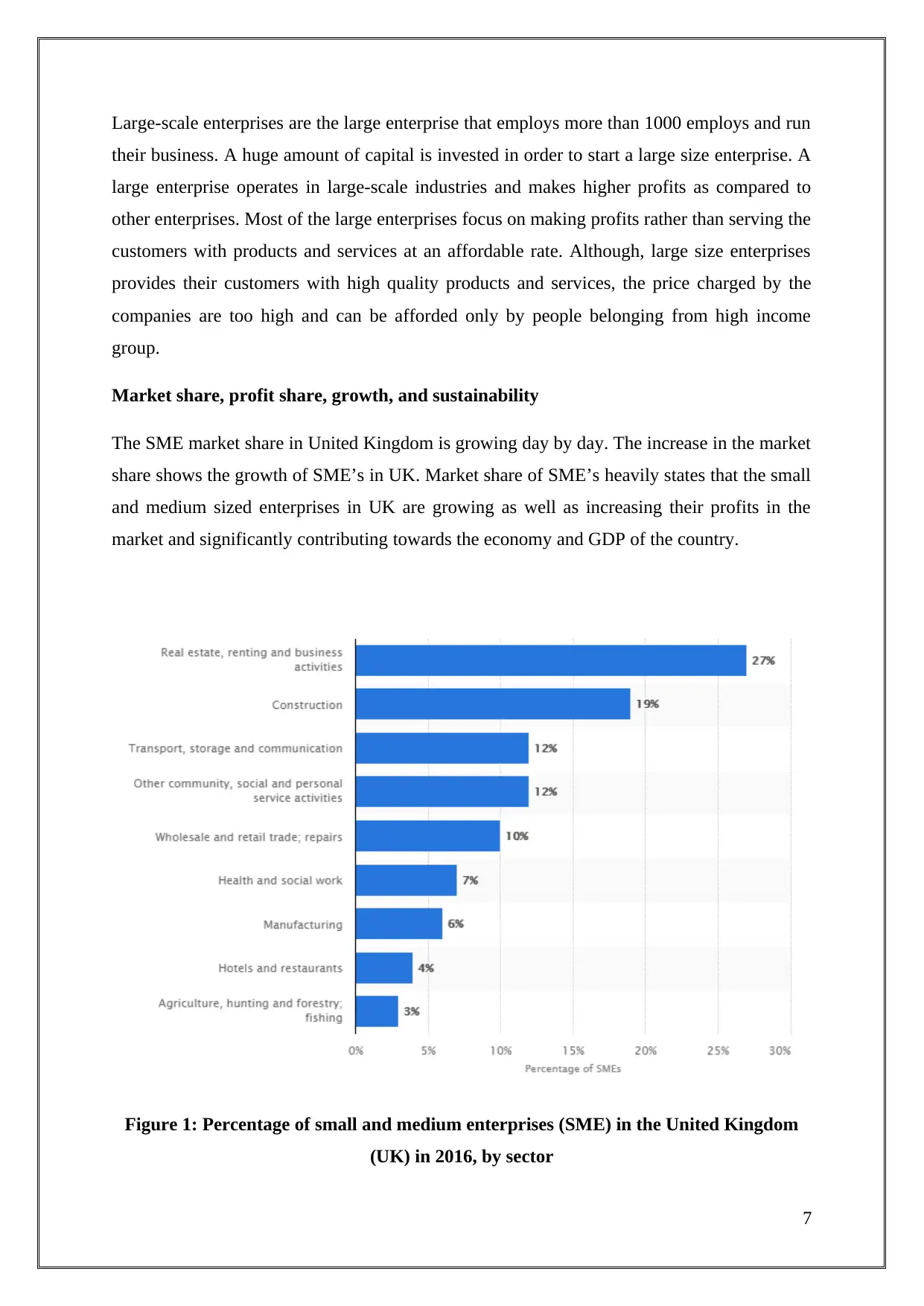
Large-scale enterprises are the large enterprise that employs more than 1000 employs and run
their business. A huge amount of capital is invested in order to start a large size enterprise. A
large enterprise operates in large-scale industries and makes higher profits as compared to
other enterprises. Most of the large enterprises focus on making profits rather than serving the
customers with products and services at an affordable rate. Although, large size enterprises
provides their customers with high quality products and services, the price charged by the
companies are too high and can be afforded only by people belonging from high income
group.
Market share, profit share, growth, and sustainability
The SME market share in United Kingdom is growing day by day. The increase in the market
share shows the growth of SME’s in UK. Market share of SME’s heavily states that the small
and medium sized enterprises in UK are growing as well as increasing their profits in the
market and significantly contributing towards the economy and GDP of the country.
Figure 1: Percentage of small and medium enterprises (SME) in the United Kingdom
(UK) in 2016, by sector
7
their business. A huge amount of capital is invested in order to start a large size enterprise. A
large enterprise operates in large-scale industries and makes higher profits as compared to
other enterprises. Most of the large enterprises focus on making profits rather than serving the
customers with products and services at an affordable rate. Although, large size enterprises
provides their customers with high quality products and services, the price charged by the
companies are too high and can be afforded only by people belonging from high income
group.
Market share, profit share, growth, and sustainability
The SME market share in United Kingdom is growing day by day. The increase in the market
share shows the growth of SME’s in UK. Market share of SME’s heavily states that the small
and medium sized enterprises in UK are growing as well as increasing their profits in the
market and significantly contributing towards the economy and GDP of the country.
Figure 1: Percentage of small and medium enterprises (SME) in the United Kingdom
(UK) in 2016, by sector
7
Paraphrase This Document
Need a fresh take? Get an instant paraphrase of this document with our AI Paraphraser
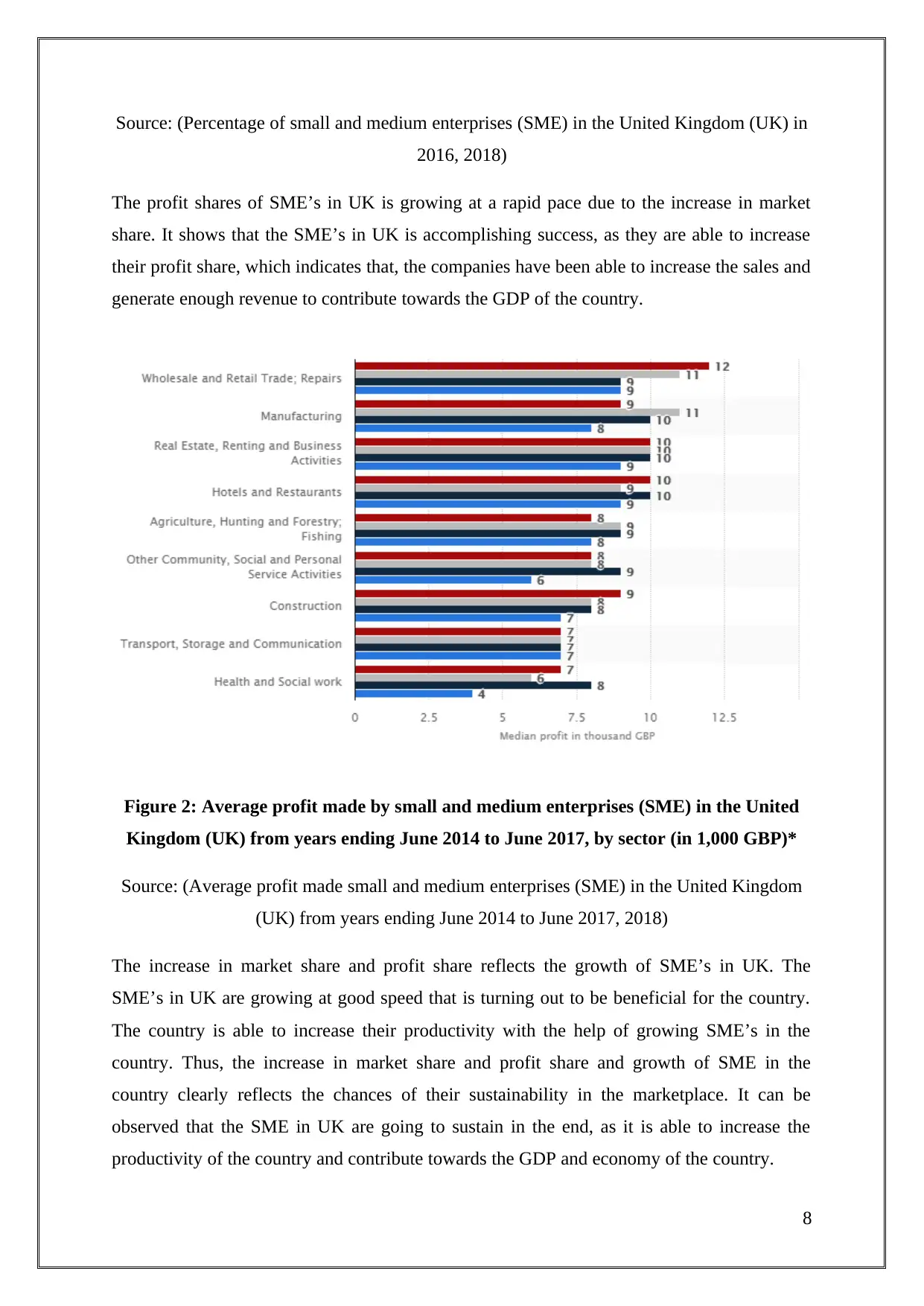
Source: (Percentage of small and medium enterprises (SME) in the United Kingdom (UK) in
2016, 2018)
The profit shares of SME’s in UK is growing at a rapid pace due to the increase in market
share. It shows that the SME’s in UK is accomplishing success, as they are able to increase
their profit share, which indicates that, the companies have been able to increase the sales and
generate enough revenue to contribute towards the GDP of the country.
Figure 2: Average profit made by small and medium enterprises (SME) in the United
Kingdom (UK) from years ending June 2014 to June 2017, by sector (in 1,000 GBP)*
Source: (Average profit made small and medium enterprises (SME) in the United Kingdom
(UK) from years ending June 2014 to June 2017, 2018)
The increase in market share and profit share reflects the growth of SME’s in UK. The
SME’s in UK are growing at good speed that is turning out to be beneficial for the country.
The country is able to increase their productivity with the help of growing SME’s in the
country. Thus, the increase in market share and profit share and growth of SME in the
country clearly reflects the chances of their sustainability in the marketplace. It can be
observed that the SME in UK are going to sustain in the end, as it is able to increase the
productivity of the country and contribute towards the GDP and economy of the country.
8
2016, 2018)
The profit shares of SME’s in UK is growing at a rapid pace due to the increase in market
share. It shows that the SME’s in UK is accomplishing success, as they are able to increase
their profit share, which indicates that, the companies have been able to increase the sales and
generate enough revenue to contribute towards the GDP of the country.
Figure 2: Average profit made by small and medium enterprises (SME) in the United
Kingdom (UK) from years ending June 2014 to June 2017, by sector (in 1,000 GBP)*
Source: (Average profit made small and medium enterprises (SME) in the United Kingdom
(UK) from years ending June 2014 to June 2017, 2018)
The increase in market share and profit share reflects the growth of SME’s in UK. The
SME’s in UK are growing at good speed that is turning out to be beneficial for the country.
The country is able to increase their productivity with the help of growing SME’s in the
country. Thus, the increase in market share and profit share and growth of SME in the
country clearly reflects the chances of their sustainability in the marketplace. It can be
observed that the SME in UK are going to sustain in the end, as it is able to increase the
productivity of the country and contribute towards the GDP and economy of the country.
8
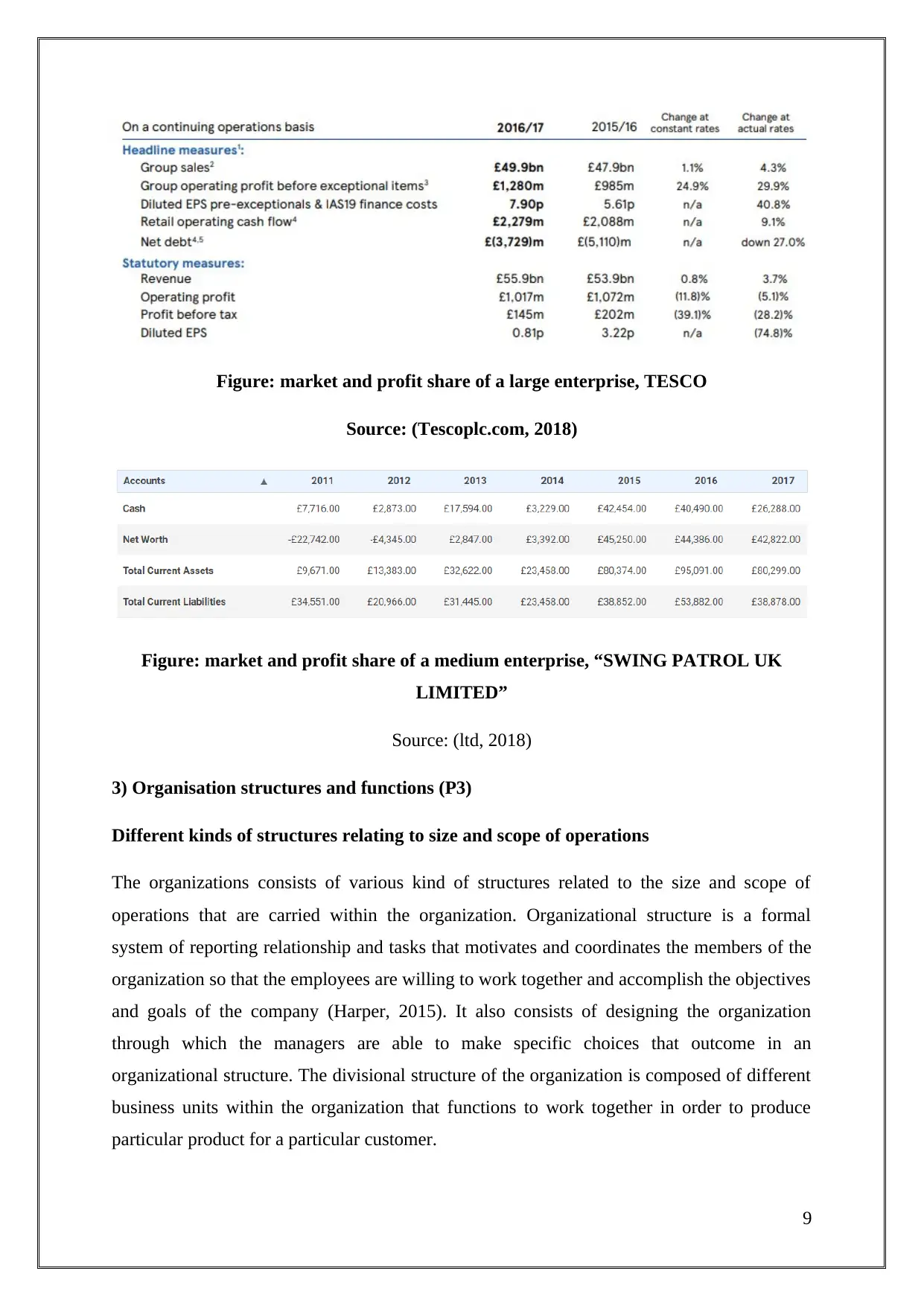
Figure: market and profit share of a large enterprise, TESCO
Source: (Tescoplc.com, 2018)
Figure: market and profit share of a medium enterprise, “SWING PATROL UK
LIMITED”
Source: (ltd, 2018)
3) Organisation structures and functions (P3)
Different kinds of structures relating to size and scope of operations
The organizations consists of various kind of structures related to the size and scope of
operations that are carried within the organization. Organizational structure is a formal
system of reporting relationship and tasks that motivates and coordinates the members of the
organization so that the employees are willing to work together and accomplish the objectives
and goals of the company (Harper, 2015). It also consists of designing the organization
through which the managers are able to make specific choices that outcome in an
organizational structure. The divisional structure of the organization is composed of different
business units within the organization that functions to work together in order to produce
particular product for a particular customer.
9
Source: (Tescoplc.com, 2018)
Figure: market and profit share of a medium enterprise, “SWING PATROL UK
LIMITED”
Source: (ltd, 2018)
3) Organisation structures and functions (P3)
Different kinds of structures relating to size and scope of operations
The organizations consists of various kind of structures related to the size and scope of
operations that are carried within the organization. Organizational structure is a formal
system of reporting relationship and tasks that motivates and coordinates the members of the
organization so that the employees are willing to work together and accomplish the objectives
and goals of the company (Harper, 2015). It also consists of designing the organization
through which the managers are able to make specific choices that outcome in an
organizational structure. The divisional structure of the organization is composed of different
business units within the organization that functions to work together in order to produce
particular product for a particular customer.
9
⊘ This is a preview!⊘
Do you want full access?
Subscribe today to unlock all pages.

Trusted by 1+ million students worldwide
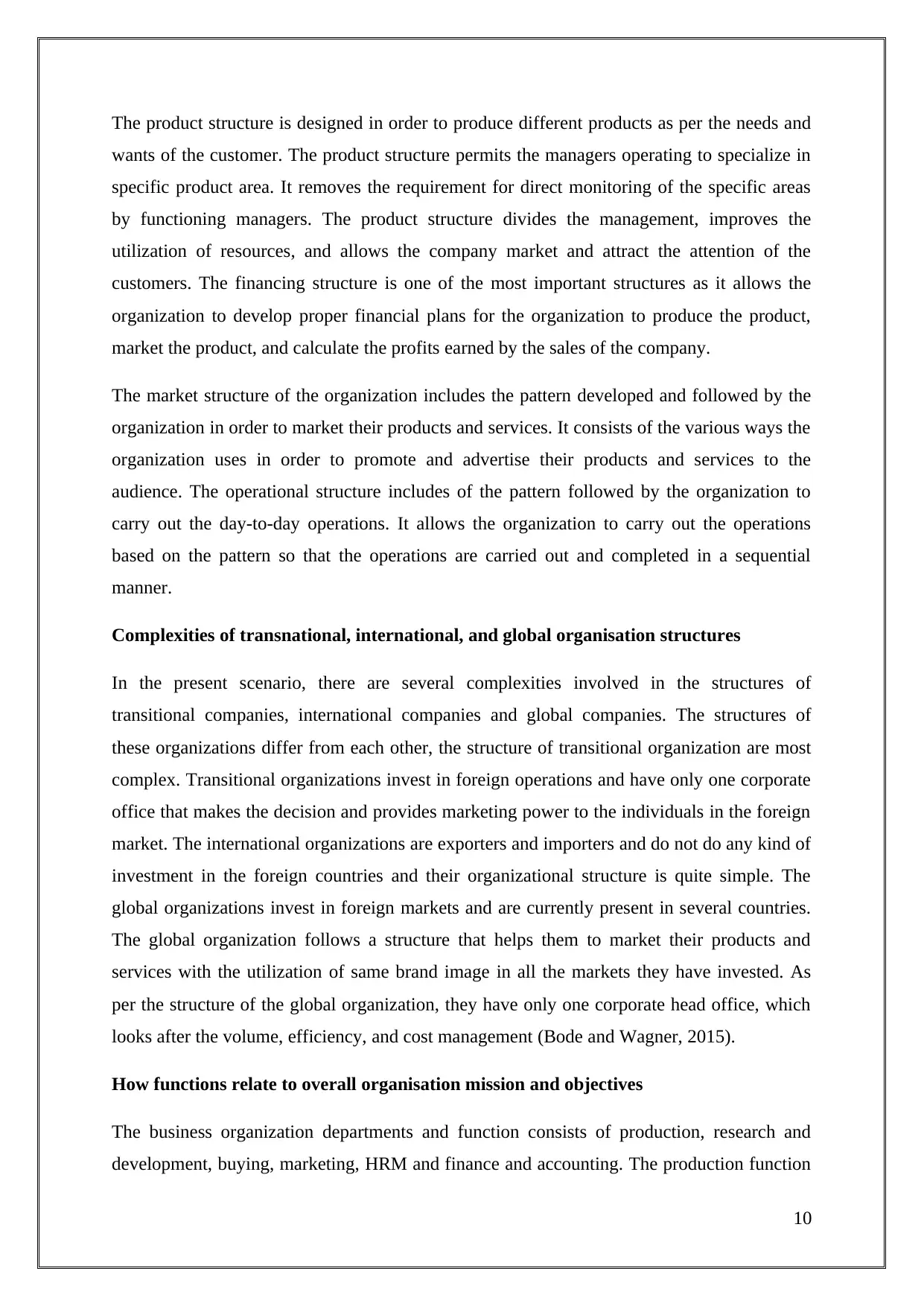
The product structure is designed in order to produce different products as per the needs and
wants of the customer. The product structure permits the managers operating to specialize in
specific product area. It removes the requirement for direct monitoring of the specific areas
by functioning managers. The product structure divides the management, improves the
utilization of resources, and allows the company market and attract the attention of the
customers. The financing structure is one of the most important structures as it allows the
organization to develop proper financial plans for the organization to produce the product,
market the product, and calculate the profits earned by the sales of the company.
The market structure of the organization includes the pattern developed and followed by the
organization in order to market their products and services. It consists of the various ways the
organization uses in order to promote and advertise their products and services to the
audience. The operational structure includes of the pattern followed by the organization to
carry out the day-to-day operations. It allows the organization to carry out the operations
based on the pattern so that the operations are carried out and completed in a sequential
manner.
Complexities of transnational, international, and global organisation structures
In the present scenario, there are several complexities involved in the structures of
transitional companies, international companies and global companies. The structures of
these organizations differ from each other, the structure of transitional organization are most
complex. Transitional organizations invest in foreign operations and have only one corporate
office that makes the decision and provides marketing power to the individuals in the foreign
market. The international organizations are exporters and importers and do not do any kind of
investment in the foreign countries and their organizational structure is quite simple. The
global organizations invest in foreign markets and are currently present in several countries.
The global organization follows a structure that helps them to market their products and
services with the utilization of same brand image in all the markets they have invested. As
per the structure of the global organization, they have only one corporate head office, which
looks after the volume, efficiency, and cost management (Bode and Wagner, 2015).
How functions relate to overall organisation mission and objectives
The business organization departments and function consists of production, research and
development, buying, marketing, HRM and finance and accounting. The production function
10
wants of the customer. The product structure permits the managers operating to specialize in
specific product area. It removes the requirement for direct monitoring of the specific areas
by functioning managers. The product structure divides the management, improves the
utilization of resources, and allows the company market and attract the attention of the
customers. The financing structure is one of the most important structures as it allows the
organization to develop proper financial plans for the organization to produce the product,
market the product, and calculate the profits earned by the sales of the company.
The market structure of the organization includes the pattern developed and followed by the
organization in order to market their products and services. It consists of the various ways the
organization uses in order to promote and advertise their products and services to the
audience. The operational structure includes of the pattern followed by the organization to
carry out the day-to-day operations. It allows the organization to carry out the operations
based on the pattern so that the operations are carried out and completed in a sequential
manner.
Complexities of transnational, international, and global organisation structures
In the present scenario, there are several complexities involved in the structures of
transitional companies, international companies and global companies. The structures of
these organizations differ from each other, the structure of transitional organization are most
complex. Transitional organizations invest in foreign operations and have only one corporate
office that makes the decision and provides marketing power to the individuals in the foreign
market. The international organizations are exporters and importers and do not do any kind of
investment in the foreign countries and their organizational structure is quite simple. The
global organizations invest in foreign markets and are currently present in several countries.
The global organization follows a structure that helps them to market their products and
services with the utilization of same brand image in all the markets they have invested. As
per the structure of the global organization, they have only one corporate head office, which
looks after the volume, efficiency, and cost management (Bode and Wagner, 2015).
How functions relate to overall organisation mission and objectives
The business organization departments and function consists of production, research and
development, buying, marketing, HRM and finance and accounting. The production function
10
Paraphrase This Document
Need a fresh take? Get an instant paraphrase of this document with our AI Paraphraser
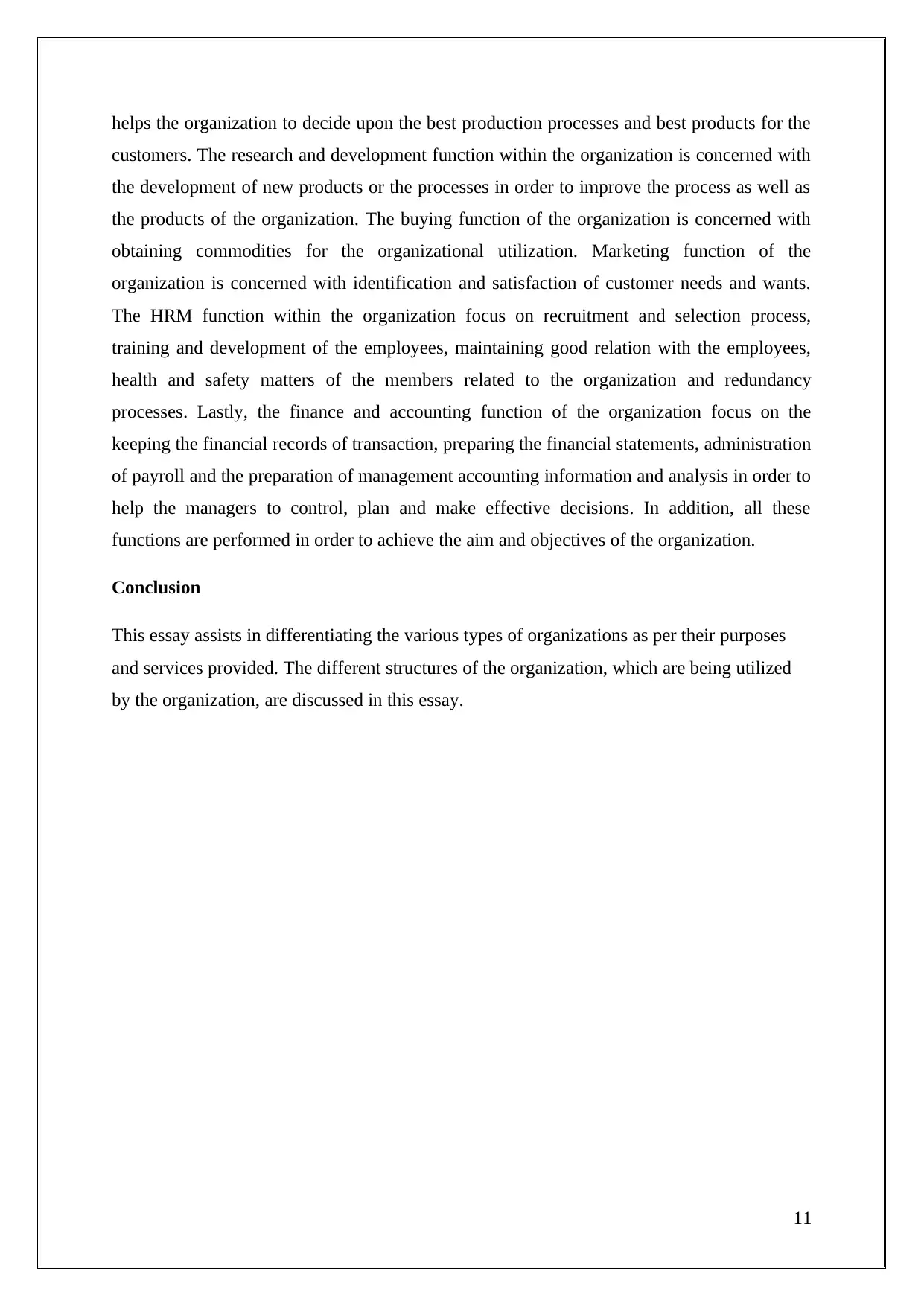
helps the organization to decide upon the best production processes and best products for the
customers. The research and development function within the organization is concerned with
the development of new products or the processes in order to improve the process as well as
the products of the organization. The buying function of the organization is concerned with
obtaining commodities for the organizational utilization. Marketing function of the
organization is concerned with identification and satisfaction of customer needs and wants.
The HRM function within the organization focus on recruitment and selection process,
training and development of the employees, maintaining good relation with the employees,
health and safety matters of the members related to the organization and redundancy
processes. Lastly, the finance and accounting function of the organization focus on the
keeping the financial records of transaction, preparing the financial statements, administration
of payroll and the preparation of management accounting information and analysis in order to
help the managers to control, plan and make effective decisions. In addition, all these
functions are performed in order to achieve the aim and objectives of the organization.
Conclusion
This essay assists in differentiating the various types of organizations as per their purposes
and services provided. The different structures of the organization, which are being utilized
by the organization, are discussed in this essay.
11
customers. The research and development function within the organization is concerned with
the development of new products or the processes in order to improve the process as well as
the products of the organization. The buying function of the organization is concerned with
obtaining commodities for the organizational utilization. Marketing function of the
organization is concerned with identification and satisfaction of customer needs and wants.
The HRM function within the organization focus on recruitment and selection process,
training and development of the employees, maintaining good relation with the employees,
health and safety matters of the members related to the organization and redundancy
processes. Lastly, the finance and accounting function of the organization focus on the
keeping the financial records of transaction, preparing the financial statements, administration
of payroll and the preparation of management accounting information and analysis in order to
help the managers to control, plan and make effective decisions. In addition, all these
functions are performed in order to achieve the aim and objectives of the organization.
Conclusion
This essay assists in differentiating the various types of organizations as per their purposes
and services provided. The different structures of the organization, which are being utilized
by the organization, are discussed in this essay.
11
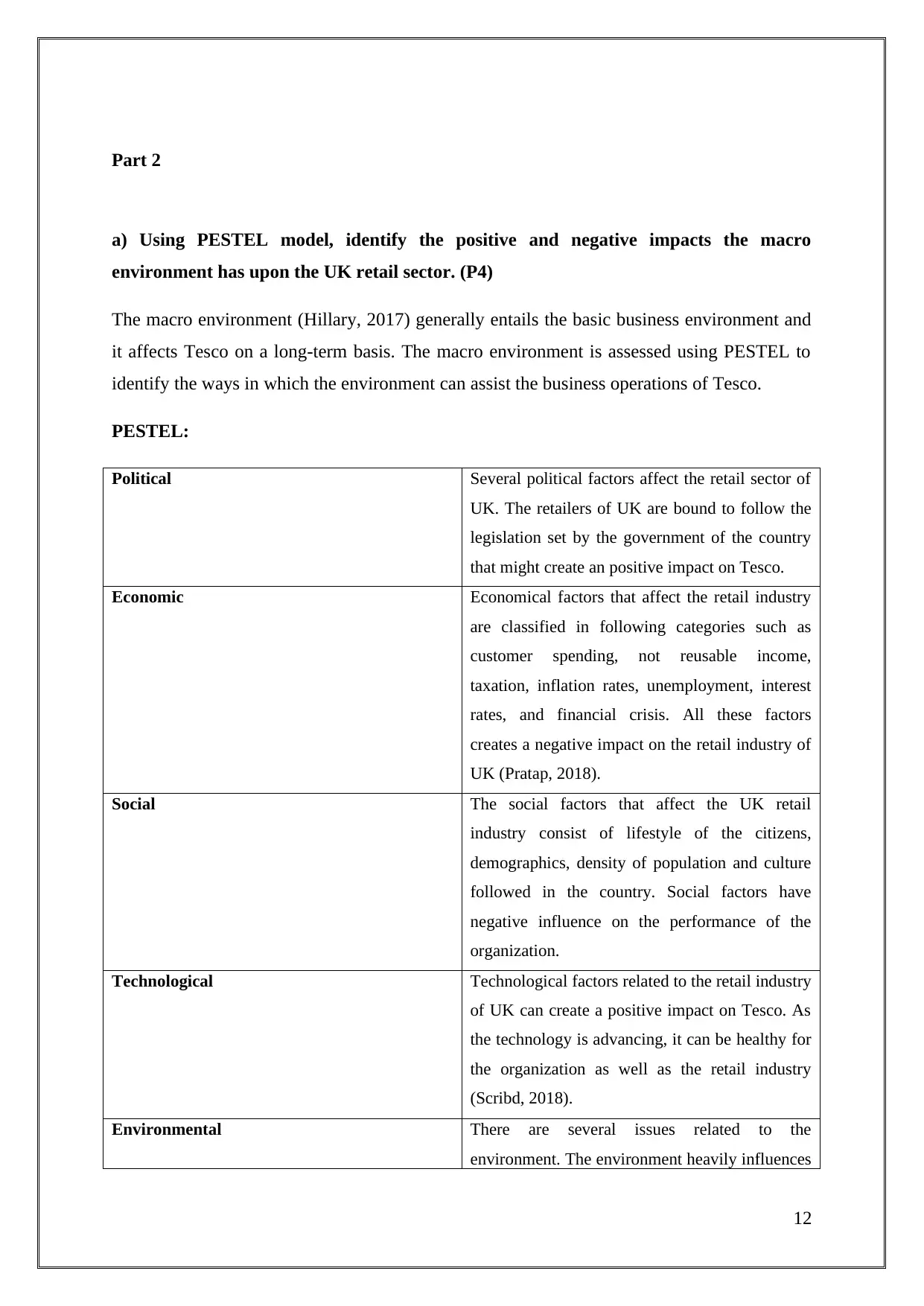
Part 2
a) Using PESTEL model, identify the positive and negative impacts the macro
environment has upon the UK retail sector. (P4)
The macro environment (Hillary, 2017) generally entails the basic business environment and
it affects Tesco on a long-term basis. The macro environment is assessed using PESTEL to
identify the ways in which the environment can assist the business operations of Tesco.
PESTEL:
Political Several political factors affect the retail sector of
UK. The retailers of UK are bound to follow the
legislation set by the government of the country
that might create an positive impact on Tesco.
Economic Economical factors that affect the retail industry
are classified in following categories such as
customer spending, not reusable income,
taxation, inflation rates, unemployment, interest
rates, and financial crisis. All these factors
creates a negative impact on the retail industry of
UK (Pratap, 2018).
Social The social factors that affect the UK retail
industry consist of lifestyle of the citizens,
demographics, density of population and culture
followed in the country. Social factors have
negative influence on the performance of the
organization.
Technological Technological factors related to the retail industry
of UK can create a positive impact on Tesco. As
the technology is advancing, it can be healthy for
the organization as well as the retail industry
(Scribd, 2018).
Environmental There are several issues related to the
environment. The environment heavily influences
12
a) Using PESTEL model, identify the positive and negative impacts the macro
environment has upon the UK retail sector. (P4)
The macro environment (Hillary, 2017) generally entails the basic business environment and
it affects Tesco on a long-term basis. The macro environment is assessed using PESTEL to
identify the ways in which the environment can assist the business operations of Tesco.
PESTEL:
Political Several political factors affect the retail sector of
UK. The retailers of UK are bound to follow the
legislation set by the government of the country
that might create an positive impact on Tesco.
Economic Economical factors that affect the retail industry
are classified in following categories such as
customer spending, not reusable income,
taxation, inflation rates, unemployment, interest
rates, and financial crisis. All these factors
creates a negative impact on the retail industry of
UK (Pratap, 2018).
Social The social factors that affect the UK retail
industry consist of lifestyle of the citizens,
demographics, density of population and culture
followed in the country. Social factors have
negative influence on the performance of the
organization.
Technological Technological factors related to the retail industry
of UK can create a positive impact on Tesco. As
the technology is advancing, it can be healthy for
the organization as well as the retail industry
(Scribd, 2018).
Environmental There are several issues related to the
environment. The environment heavily influences
12
⊘ This is a preview!⊘
Do you want full access?
Subscribe today to unlock all pages.

Trusted by 1+ million students worldwide
1 out of 18
Related Documents
Your All-in-One AI-Powered Toolkit for Academic Success.
+13062052269
info@desklib.com
Available 24*7 on WhatsApp / Email
![[object Object]](/_next/static/media/star-bottom.7253800d.svg)
Unlock your academic potential
Copyright © 2020–2025 A2Z Services. All Rights Reserved. Developed and managed by ZUCOL.





